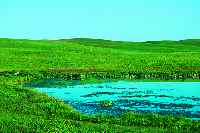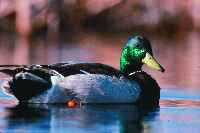| |
Beneficial Management Practices: Environmental Manual for Crop Producers in Alberta - Wetland and Riparian Land | |
| |
|
|
| |
|
|
| | Wetlands are lands covered by water for all or part of the year. They are wet long enough to influence soil characteristics and to support water-loving plants. Healthy wetlands and riparian areas are important in reducing flooding, preventing erosion, protecting water quality and providing habitat.
BMPs to improve habitat in wetland and riparian areas include:
- Retain temporary wetlands. Small spring ponds provide important early spring breeding habitat for wildlife.
- Grow perennial forages for hay in wet areas to provide habitat for birds, small mammals, amphibians and insects, and hiding cover for fawns.
- Avoid cultivating near the edges of wetlands.
- Maintain, restore or enhance riparian vegetation to provide: breeding, feeding, nesting sites, travel corridors, food and cover for many bird species; critical habitat for deer, moose, elk and pronghorn antelope; shade and temperature regulation for improved fish habitat.
- Delay mowing and haying of grassed waterways and other wet areas until mid-July to reduce nesting losses and fawn mortality. Use a flushing bar when haying.

Winter wheat provides benefits to nesting water fowl and other ground nesting birds.
Courtesy of DUC

Habitat and wildlife are inseparable.
Courtesy of DUC
Back to Chapter 7 - Wildlife Habitat |
|
| |
|
|
| |
For more information about the content of this document, contact Roger Bryan.
This document is maintained by Jennifer Rutter.
This information published to the web on November 1, 2004.
Last Reviewed/Revised on October 30, 2017.
|
|